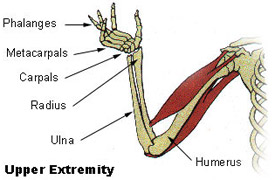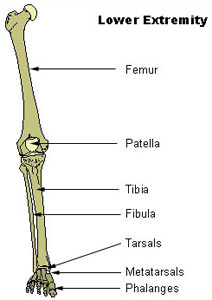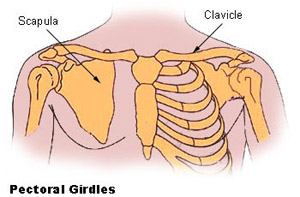|
Bones and Martial Arts
Bones in martial arts are important in the following ways:
- Bones can be injured during training. For example, breaking a femur during sparring.
- Bones are potential targets in self-defense scenarios. For example, breaking a finger in order to escape a rapist's grasp.
- Bones can be made stronger via vigorous exercise and conditioning. Just as muscle mass is generated from healing of micro tears in muscles, bone density/strength can be increased from microfracture bone growth/remodeling.
There are over 200 bones in the human body. Listed below are the major bones in order to help you learn more about the anatomy of the human body and thus improve your martial arts training. For more martial arts anatomy information, please visit the main Anatomy section.
List of Major Bones
Those that are useful knowledge for martial arts, where they are located, and their usefulness.
- Cranium - The skull as a whole. This is a complex of multiple bones sutured together. See picture below.
- Frontal bone - "Forehead" The center of this bone (often near the hairline) is the hardest portion and used in the forward headbutt.
- Sphenoid bone - "Temple" This is a thin area, though covered by muscular attachment to the jaw, is a target for a knockout strike.
- Nasal bone - Top part (hard) part of the nose.
- Zygomatic bone - Right below and to the outside of the eye, forms part of the eye socket. A solid palm heel strike can do a lot of damage here in a self-defense situation and affect the inner portion of the eye socket (ie. internal bleeding of the socket).
- Parietal bone - Part of the "top" and "back" of the head. The crown of the head is roughly its center. Placing your hand on the crown of your head (relaxed and open) the pinky will land near the suture between the parietal and frontal bone which is often the target for a downward elbow strike to the top of the head.
- Mandible - The jaw bone. Particularly the mandibular condyle which helps form the hinge of your jaw and is located right in front of the ear. Placing your fingers right in front of your ear and opening your mouth all the way you can feel this piece. Striking this location can break the jaw, dislocate the "hinge", and even cause multiple fractures to bone structures by the ear.
- Occipital bone - The bottom back of the skull. This is where the skull attaches to the spine (about an inch higher than your neck hairline). Severe fracturing and knockout/brain damage can occur if this spot is struck by an assailant.
- Cervical bones - The bones that make up the neck portion of the spine (there are 7 of them). Like the whole spine, they encase the spinal cord but due to their smaller size can be fractured and cause nerve damage. A typical "Karate chop" would work well to these bones.
- Atlas - Connects with the occipital bone (about an inch higher than your neck hairline). Also its joint can be popped/broken with enough force pushing the skull forward or backwards (note that it would require a lot of force).
- Chest cavity
- Sternum Manubrium - This is the small top part of the sternum. It visibly forms the jugular notch, a reference point for spear finger strike to this area. This bone is also responsible for anchoring the clavicle to the chest cavity, there fore a substantial strike (such as palm heel, hammer fist, elbow) can fracture/break it and likely to fracture the clavicle as well.
- Sternum body - The central part of the sternum/breast bone at the center of the chest between the pecs. This bone anchors the ribs coming from the spine encasing the chest cavity. This is a well secured bone that would require a substantial kick (possibly elbow strike) to fracture or break. Best would be a spinning back kick that would fracture/break the sternum and result in multiple rib fractures.
- Thoracic vertebrae - These are the bones of the spine, there are 12, each connected to a rib. They are fairly durable encasing the spinal chord but make a poor striking target. Because the encase the spine, this is the reason for a typical roll to go from one shoulder to opposite hip, therefore minimizing the time that the spine is in contact with the ground.
- True Ribs - Ribs 1-7, starting just below the clavicle and ending just below the pectoralis major. These are true ribs because they attach directly to the sternum encasing the chest cavity. These ribs are well attached and covered by the pectoralis major and the serratus anterior making them a poor target for an attack, only likely to be injured with extreme force to these ribs or to the sternum.
- False ribs - Ribs 8-12, starting just below the pectoralis major. Most of these ribs are attached via cartilage to the sternum making them weaker structure. They are likely to break with a decent kick, knee, or elbow strike. Ribs 11 & 12 are floating ribs meaning that they are only attached at the spine. This makes them a prime target for anything from a kick to even and upper cut or a side jab. If broken with enough force they are likely to shatter and send fragments into internal organs. Their fragility is the reason for keeping elbows down in a typical fighting stance.
- Upper extremity - The arm and associated bones.
- Clavicle - Collar bone. It stabilizes the joint of the arm allowing it to hang freely. Therefore breaking this bone with a chop or elbow strike (even an axe kick) will greatly hinder the function of the arm nearly rendering it useless. This is the most commonly broken bone as its slender shape acts similar to a crumple zone in a car.
- Scapula - Shoulder blade. It anchors the humerus to the clavicle. Impact to this bone is unlikely and hard to achieve, though if behind your opponent (say locking the arm in a hold) fracturing it with an elbow strike would impair the function of up to ~18 muscles that attach to it.
- Humerus - Upper arm bone. This is a durable long bone surrounded by a lot of muscle (biceps, triceps, ect.) and therefor unlikely to break from an average strike. Its length and size does make it (the upper arm as a whole) easier to bar and block, temporarily disrupting the functionality of the arm. It is very common though to break any of the three long bones in the arm, hence proper break-falls should be learned.
- Radius - Forearm inside bone (on the side of the thumb). This bone is on the inside, thinner than but relatively protected by ulna against outside force. If you are using a block that implements blocking/striking at the inside of the arm, it is likely to cause a distal radial fracture or what many know as a broken wrist.
- Ulna - Outside forearm bone. This is a fairly strong bone as it is the main force behind blocking (with the arm) in martial arts. Though commonly broken by a fall.
- Olecracon process - The tip of the elbow (part of the ulna). This is the main force behind any elbow strike as it is very strong and can do a lot of damage with enough force. It is typical to break when falling which is why break-falls are important to never land on the elbow.
- Styloid process - The bony tips of the radius and ulna that attach to the carpals. This is the striking surface of a goose neck strike, many martial artists make the mistake of striking with the carpals and can seriously injure their hands.
- Carpals - Wrist bones. There are 8 of these little bones that facilitate in the movement of the hand. They can be broken during an unprotected fall or with enough pressure to the back of the hand (in wrist lock) which could cripple the hand.
- Metacarpals - Hand bones. These five bones are between the fingers and carpals making up the hand. These bones are moderately durable as they can support a decent amount of force such as a proper punch but can also be injured the same ways hence boxers wrapping their hands to prevent damage. Striking these and the phalanges with a stick is the concept of "de-fanging the snake" in Escrima, breaking the stick hand and rendering it useless.
- Phalanges - The fingers. Should only be used as a striking surface to targets such as the eyes or throat. They are useful for grabbing an opponent but for all other strikes (open and close) should be protected against impact as they are likely to break. They are the target of "de-fanging the snake" in Escrima and for women being inappropriately touched. For example a man grabs the breast of a woman, her best option would be to use one hand to pin his hand to her chest and with the other hand grab, twist, and break his finger causing a severe amount of pain.
- Pelvic girdle - Lower trunk/hips.
- Lumbar vertebrae - Lower back bones. These are the largest of the vertebrae as they support the central mass of your body weight. Breaking or fracturing them can literally cripple the legs (if there is sufficient nerve damage) and therefore backwards break falls lift the hips and lower back off the ground. If needed and behind an aggressor a knee strike to this area would be painful.
- Ilium - The hip. The bony portion of your hip below the waist. This is a hard bone and a poor target for a kick besides knocking your opponent off balance. The sturdiness and hardness of this bone makes it very useful in throwing an opponent from the hip.
- Ischium and Coccyx - "Butt" bone and tail bone. The ischium is the bone that you feel when you sit down and the tail bone right between the glutes. These bones are likely to be fracture or broken when sweeping an opponent in such a way that they land on their butt, not life threatening but can cause a decent amount of pain.
- Lower extremity - The leg.
- Femur - Thigh bone. The femur is the longest and strongest bone in the body, in some spots stronger than concrete. The weakest part of it however (and weaker the older the person) is just below the head (forms the ball joint with the hip socket). A strong scoop or shin kick could break the bone at this point (aimed at the top of the thigh) and result in the common broken "hip".
- Tibia - Shin bone. The prominent feature of this bone, the shin, at the front of the lower leg. This is the next longest and strongest bone after the femur, used a lot in muay thai shin kicks. Because of the lack of muscle at this location this bone is often conditioned by martial artists via the use of constant progressively harder impacts that create microfractures in the bone, which the bone cells fill in/recalcify the cracks thus increasing bone density and durability over the long term (years of consistent training). It is slightly common to be broken in a major fall or from the impact of an opponent's shin kick.
- Patella - Knee bone. This bone covers the joint between the femur and the tibia and the striking surface for most knee strikes. This is a fairly strong bone/mechanism for striking with but a direct hit to the patella (say with a scoop kick) could fracture it and impair the muscular movement of the lower leg.
- Fibula - Calf bone. This is a fairly thing bone running down the side of the calf and ending at what is commonly known as the ankle. Because this bone runs on the lateral (outside) side of the leg it can be fairly easily broken from a fall or a shin kick, resulting in a typical "broken ankle".
- Tarsus - The seven bones that make up the ankle. They form a durable complex but can be fractured from rolling the ankle more severely than a sprain. If able to take down an aggressor grabbing their foot and sharply twisting it is likely to break one of the smaller tarsals such as the small cuneiform bones. Breaking/fracturing any bone from this move will allow escape with the attacker unable to stand.
- Calcaneus - The heel. Also the largest of the tarsals. This bone makes the strong striking surface of a heel kick, the force of this kick arguably best conveyed to the sternum or the toes of an aggressor.
- Cuneiform bones - Three tightly packed bones that form the top hard part of the foot. Though not as strong as the calcaneus they make a hard enough surface for a groin kick or moderately hard round house kick.
- Metatarsals - Middle foot bones. The ends of these bones make the ball of the foot which is the striking surface of a basic front kick. Impact from a heel kick could easily break/fracture these bones quickly hindering the function of the foot.
- Tuberosity process - Bony outside or knife edge of the foot, this is a process of the fifth metatarsal (the one that connects to the pinky toe. This is a fairly thick and supported portion of the fifth metatarsal and used in a side kick.
- Phalanges - Toes. They are fragile, for example needing to be curled forward during a groin kick or pulled back during a basic front kick. Breaking/fracturing them with a keel kick is painful, movement hindering, and allows for a quick get away from an attacker.


 References
- National Cancer Institute, Divisions of the Skeleton, http://training.seer.cancer.gov/anatomy/skeletal/divisions/, Added - 5/11/14
- Picture of Skull provided by Wikimedia Commons, https://commons.wikimedia.org/, Added - 04/09/15
- Anatomy details kindly provided by Chris Adamchek, https://www.pinterest.com/gojuchrisa/karat%C3%A9-%2B/, Added - 04/14/15
bones/html/59aea5a0a38cf5f1ed580813e5e9fb64669c31ba-1325888021787745144
|
|







